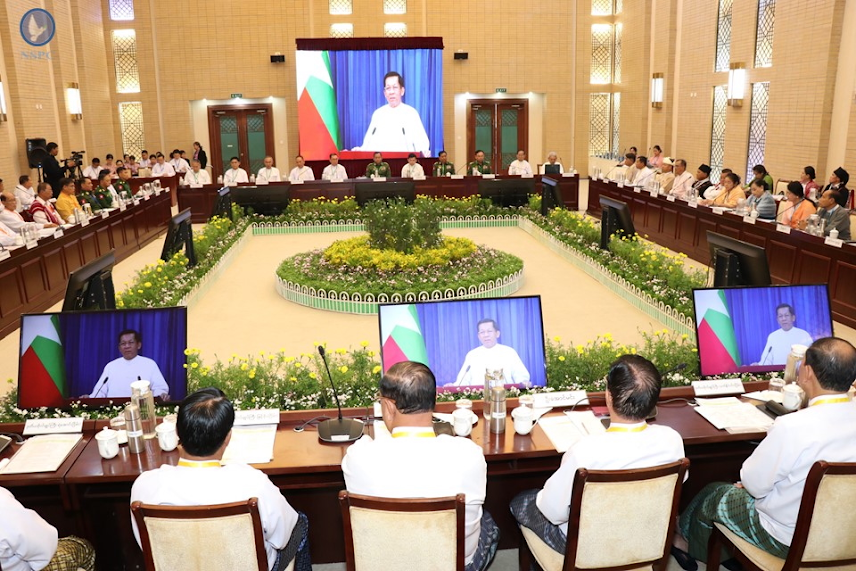Myanmar Spring Chronicle – October 13: Scene
(MoeMaKa, October 14, 2025)
A Decade of the Nationwide Ceasefire Agreement (NCA): Commemorating Peace in a Time of War
Ten years ago, on October 15, 2015, the Nationwide Ceasefire Agreement (NCA) was signed between the government of President U Thein Sein and eight armed organizations — seven ethnic armed groups and the All Burma Students’ Democratic Front (ABSDF).
After nearly five years of negotiations and informal talks that began in late 2011, the NCA was signed just before the 2015 general election, marking what many saw as a milestone in Myanmar’s long pursuit of peace.
Among the eight signatories, the only groups with significant troop strength and territory were the Karen National Union (KNU) and the Restoration Council of Shan State (RCSS). The others — the Arakan Liberation Party (ALP), Chin National Front (CNF), Democratic Karen Benevolent Army (DKBA), KNU/KNLA (Peace Council), Pao National Liberation Organization (PNLO), and ABSDF — were comparatively smaller in manpower and territorial control.
Several other groups declined to sign in 2015. Three years later, in 2018, the New Mon State Party (NMSP) and the Lahu Democratic Union (LDU) joined as second-round signatories.
The signing of the NCA in 2015 briefly raised hopes that Myanmar was finally moving closer to peace. When the National League for Democracy (NLD) took office after its landslide victory in the 2015 election, optimism grew further. Yet, during the ensuing Union Peace Conferences (21st Century Panglong sessions), differences between the military and ethnic organizations — and later, between the military and the NLD government itself — became apparent. As a result, the peace process stalled.
The military’s obstruction of peace efforts under the NLD became unmistakable during the August 2020 Peace Conference, when Commander-in-Chief Min Aung Hlaing’s speech used rhetoric starkly out of step with a peace event, emphasizing control and obedience rather than reconciliation.
Before the coup, some of Myanmar’s fiercest fighting had already reignited — particularly in Kachin State, the Kokang region, and Rakhine State. The 17-year ceasefire between the Kachin Independence Army (KIA) and the military collapsed in June 2011, leading to ongoing conflict. In Rakhine, the Arakan Army (AA) rose to prominence with heavy clashes in 2018–2019, while in the Kokang region, the MNDAA, under commander Peng Jiasheng, launched a major offensive in 2015 that lasted months.
After the NLD’s second electoral victory in November 2020, the February 2021 coup rendered the NCA essentially meaningless. Despite claiming adherence to the NCA, the junta has since fought fiercely against many of its original signatories while simultaneously invoking the agreement for political legitimacy.
The junta has repeatedly announced its willingness to hold peace talks, but most of the major ethnic armed groups no longer trust it in any form since the coup.
Meanwhile, as the junta faces simultaneous offensives from ethnic armed organizations (EAOs), the National Unity Government (NUG), and various People’s Defense Forces (PDFs), many groups now view this period as a strategic opportunity to fight for genuine liberation in their territories.
Currently, the AA in Rakhine, KNDF in Karenni (Kayah), the MNDAA and TNLA in northern Shan, the CNF in Chin State, and the KIA in Kachin State have all captured towns and large areas from the junta, expanding their control.
In this context, peace negotiations have lost credibility. For most armed groups, the notion of “peace talks” now represents a political maneuver, not a genuine solution.
There is a saying: “In the end, all conflicts are resolved at the negotiation table.” Yet in Myanmar’s reality, only those who hold military strength and territorial control can expect their demands to be respected at that table — an enduring belief that still shapes the behavior of all sides.
Myanmar’s peace process has never been purely domestic. The stance and strategic interests of China, the country’s most influential neighbor, play a crucial role. Beijing’s policies — shaped by its own regional ambitions — heavily influence whether Myanmar’s internal conflicts intensify or de-escalate.
In recent months, the junta’s ability to regain some initiative has owed much to Chinese backing. While China cannot fully determine Myanmar’s future, it has significant leverage to delay, redirect, or restart developments in the country’s conflict.
Earlier this year, for instance, Beijing reportedly pressured the MNDAA to halt operations and withdraw from Laukkai, leading to temporary pauses in fighting.
The upcoming 10th anniversary commemorations of the NCA, along with associated “peace forums” expected to include UWSA, NDAA (Mongla), and SSPP/SSA, are likewise believed to be taking place under Chinese pressure.
However, as long as the junta continues to brandish the NCA while waging war and clinging to the 2008 Constitution, it will gain little acceptance among ethnic armed groups. Likewise, even if it holds another election under that same constitution, the junta faces massive territorial losses and lacks popular legitimacy—making any future electoral outcome deeply uncertain.

